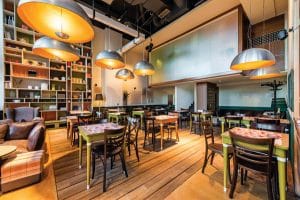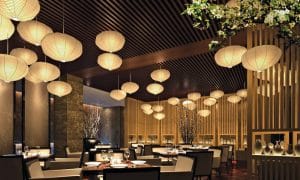 Adopting or switching to LED lighting makes sound business sense in the hospitality business. With hotels and restaurants facing increasing competition, creating attractive and sustainable environments that are also cost effective has never been more important. The hotel industry has been greatly impacted by LED technology, with contemporary lighting methods getting integrated into hotel architecture.
Adopting or switching to LED lighting makes sound business sense in the hospitality business. With hotels and restaurants facing increasing competition, creating attractive and sustainable environments that are also cost effective has never been more important. The hotel industry has been greatly impacted by LED technology, with contemporary lighting methods getting integrated into hotel architecture.
By Baishakhi Dutta
Compared to traditional incandescent and fluorescent lighting fixtures, the luminous efficacy of LED lights is much higher. LED lights save 10 times more energy, and hence slash the cost of electricity, and have a life span that’s 30 times longer. The lighting efficacy of an LED is approximately 300lm/watt and its average life span is 100,000 hours.
Based on their requirements, businesses can explore a selection of LED lighting categories. The first is ambient lighting, which provides a soft, comfortable level of light—suitable for relaxing activities like watching television or having a conversation. The second category is task lighting, which can be used in dining areas like cafes, hotel kitchens, etc. The final category is accent lighting, which highlights an area or an object like a sculpture or painting.
Technology trends
The lighting industry has always been very dynamic. With the growing popularity of LEDs in the hospitality sector, we are getting a chance to explore newer and better options in this space. There are several trends that have emerged in the lighting industry, some of which are listed here.
Smart connectivity: Everything from applications to gadgets is connected via the Internet in today’s world. Lights that are controlled via the Net are the new entrants in the market. The Internet of Things has impacted the realm of lighting as well, so users can control the lights in their room with the help of apps on their smartphones.
No wires: LED lights even come without wires today, which makes them easy to install and replace.
Inbuilt sources: The light sources of LED lights from reputed manufacturers, who ensure the drivers are tested, do not require to be replaced throughout their lifetime. Manufacturers nowadays work on creating light sources that are inbuilt, which don’t require any lamps or moulds to cover them. These are easily available, and come in various sizes and styles.
New and innovative designs: Geometric lighting fixtures are amongst the hottest lighting trends now. These lights invoke a minimalist aesthetic and are not just for modern and contemporary interiors. The key to their versatility is utter simplicity. “The geometric trend is a great option if you’re looking to give your space a modern or mid-century vibe,” says Rhambo Zhang, general manager, Opple Lighting.
Environment-friendly: The major focus today is to keep the environment healthy by using the best of resources. LEDs are devoid of any chemicals that might be a health hazard (compared to fluorescent lights, which contain hazardous mercury).
The benefits of upgrading to LED lighting
Apart from energy efficiency and a long life span, designers and architects are using LEDs for other reasons also, such as those listed below.
Better controls: With the use of controls, LEDs can be auto-dimmed as and when required. They also have the ability to send and receive data. Energy consumption data can help organisations to track their power usage patterns and expenditure, and hence regulate usage. Improvements in user interfaces, and the presence of smartphones and tablets, are also helping.
A few hotels that have switched completely to LEDs
-
Taj Palace, New Delhi
-
Cafe Ludus, New Delhi
-
Lemon Tree Hotels (across India)
-
The Lalit, New Delhi
-
The Leela Kempinski Ambience, Gurugram
Cost friendly: These lights are easy to maintain and have a longer running life. With prices falling considerably in the last few years, they are no longer very heavy on the pocket too. These lights can illuminate an area in different ways, while consuming much less energy compared to other lighting options. On an average, LED bulbs save up to a massive 85 per cent of energy in the hospitality sector.
Better flicker: and heat-management: Flicker has been one of the most common causes of ailments like headaches. LED lamps ensure flicker-free light, helping avoid health issues. These lights are also designed with efficient heat sinks for powerful heat management. The technology that goes into making LEDs ensures that the lamps are safe to touch even during operation because they generate much less heat.
 UV free: Harmful UV rays emitted from lights can severely affect the skin, eyes and the immune system. LED lamps protect humans from harmful UV rays and that leads to a healthier life.
UV free: Harmful UV rays emitted from lights can severely affect the skin, eyes and the immune system. LED lamps protect humans from harmful UV rays and that leads to a healthier life.
In the hospitality segment, the focus is on being ‘different’, and architects and interior designers play a very important role with respect to the choice and installation of LED lights. According to Zhang, installing LED lights at new or under-construction hotels is an easy task. However, changing over from incandescent lights in older properties is a bit tricky. One needs to also take care of the original aesthetics created by the architect when replacing conventional lights with LED lights.
Industry’s take
Rhambo Zhang, general manager, Opple Lighting
“LED technology was a costly affair initially, but with time and technological developments, these lights have become cheaper. Governments are encouraging people to cut their energy usage and thus contribute towards a sustainable environment. LED light companies are continuously working on conserving energy. They are creating new and innovative lights that are suitable for the Indian consumer and are pocket-friendly. Over the last few years, the use of LED bulbs and streetlights has gone up in homes, offices and on the roads all over the world.”
Commenting on the worldwide scenario worldwide scenario, Zhang says that the LED sub-sector within the hospitality sector is expected to grow at a CAGR of 7.13 per cent during the period 2017-2020.
“The market landscape and its growth prospects over the coming years will completely change the way lighting works in the hospitality sector,” he says.
Investing in LED lighting solutions can prove to be a major business-booster and money-saver for players in the hospitality industry.




























